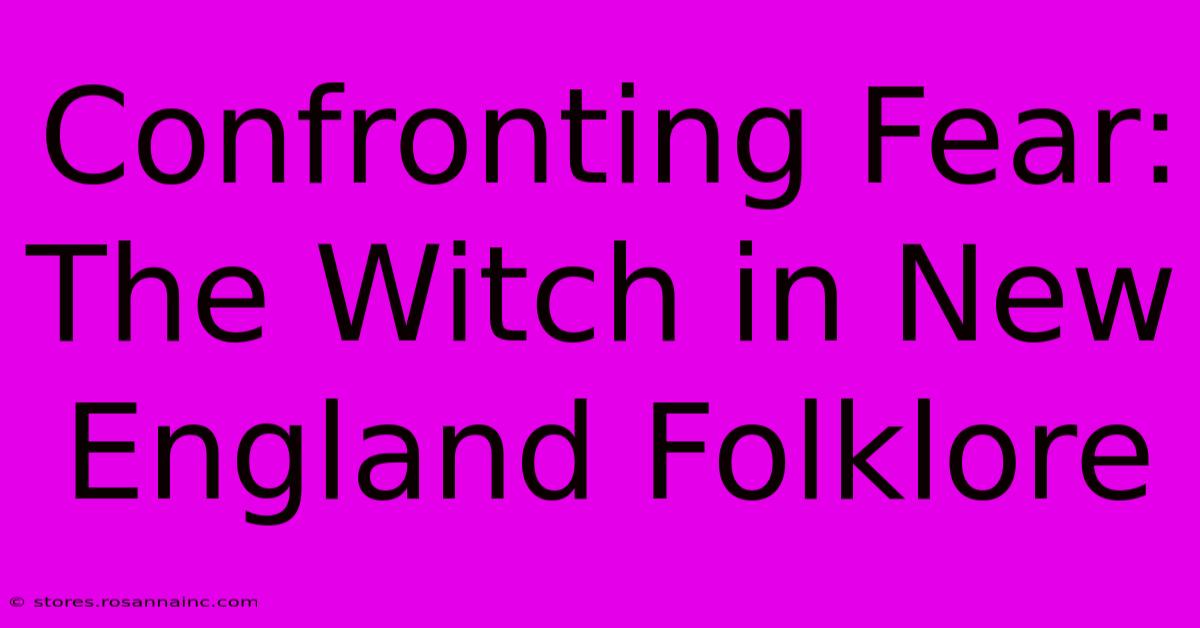Confronting Fear: The Witch In New England Folklore

Table of Contents
Confronting Fear: The Witch in New England Folklore
New England. The very name conjures images of crisp autumn air, vibrant foliage, and… witches. While the modern perception of witches is often romanticized, the historical reality in New England, particularly during the 17th and 18th centuries, was far more complex and terrifying. Understanding the role of the witch in New England folklore reveals not only a fascinating glimpse into the past but also a reflection of societal anxieties and the enduring human struggle against fear.
The Seeds of Fear: Societal Context
The witch trials, most famously in Salem, Massachusetts, weren't born in a vacuum. Several factors contributed to the widespread belief in and fear of witchcraft:
Religious Intolerance and Puritanism: The strict Puritan religious beliefs prevalent in New England fostered an environment of suspicion and intolerance. Deviation from the accepted norms, even minor disagreements, could be easily interpreted as evidence of demonic influence. This created a climate where accusations could flourish.
Frontier Life and Uncertainty: Life in the New England colonies was harsh. Disease, famine, and the ever-present threat of Native American attacks created a sense of vulnerability and uncertainty. Blaming misfortunes on witchcraft offered a seemingly simple explanation for these inexplicable events.
Social Tensions and Power Dynamics: Accusations of witchcraft were often used as a tool to settle personal scores or to target individuals who were marginalized or unpopular within the community. Women, in particular, were disproportionately accused, reflecting the patriarchal structure of the time. Accusations could be motivated by land disputes, financial conflicts, or simple social grievances.
The Witch in New England Folklore: More Than Just a Hag
The image of the stereotypical cackling witch on a broomstick is a later, romanticized interpretation. The witches of New England folklore were far more varied and nuanced:
Shapeshifting and Maleficence: Many accounts described witches as capable of shapeshifting, often appearing as animals like cats or dogs. They were believed to inflict harm through curses, spells, and the sending of familiars – often depicted as black cats or other animals – to torment victims.
The Devil's Pact: The idea of a pact with the Devil was central to the concept of witchcraft. Witches were seen as having willingly surrendered their souls in exchange for supernatural powers, making them inherently evil and deserving of punishment.
Spectral Evidence: A particularly problematic aspect of the witch trials was the reliance on "spectral evidence"—testimony about dreams, visions, and apparitions of the accused. This subjective and unreliable evidence contributed significantly to the mass hysteria and the unjust convictions that followed.
Confronting the Legacy of Fear
The Salem witch trials and the broader history of witch hunts in New England serve as a stark reminder of the dangers of mass hysteria, religious intolerance, and the abuse of power. While the trials officially ended centuries ago, their legacy continues to shape our understanding of fear, prejudice, and the importance of critical thinking.
Understanding Historical Context: It's crucial to understand the historical context in which these beliefs emerged and to avoid simplistic interpretations. The fear of witchcraft wasn't simply the result of irrational superstition but rather a reflection of complex social, political, and religious forces.
Challenging Superstition: The story of the New England witch serves as a cautionary tale against the dangers of unchecked superstition and the importance of critical thinking in the face of fear and uncertainty.
Conclusion: The Enduring Power of Narrative
The witch in New England folklore is more than just a historical figure; she is a potent symbol of fear, social anxieties, and the enduring power of narrative. By understanding her role within the historical context, we can better appreciate the complexity of human belief systems and the ongoing struggle to overcome prejudice and intolerance. The story of the New England witch is a chilling reminder of the fragility of justice and the importance of questioning authority—a lesson as relevant today as it was centuries ago.

Thank you for visiting our website wich cover about Confronting Fear: The Witch In New England Folklore . We hope the information provided has been useful to you. Feel free to contact us if you have any questions or need further assistance. See you next time and dont miss to bookmark.
Featured Posts
-
Think You Re Too Smart To Be Scammed Think Again Theres A Sucker Born Every Minute
Feb 09, 2025
-
Pete Hegseth How Military Service Shaped A Fox News Star
Feb 09, 2025
-
How Much Liquor Is Enough The Fifth Breakdown
Feb 09, 2025
-
On Probation Navigate It Successfully With This Guide
Feb 09, 2025
-
Unforgettable Spain Explore Setenil De Las Bodegas
Feb 09, 2025
